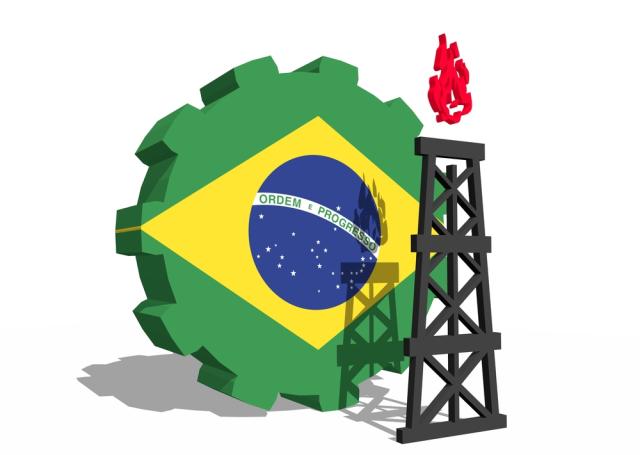
Source: Shutterstock.com
RIO DE JANEIRO—For many years, shale gas activities have been discussed without due importance in Brazil. However, this may change over the next few years, according to ANP, Brazil’s oil and gas regulator. The goal is to follow what has been done in U.S. shale plays and try to adapt the technology and methods implemented by U.S. companies.
“I think this discussion should have happened in Brazil some time ago. Brazil has the potential for unconventional gas,” said ANP general director Decio Oddone. “It is very frustrating to redo every day the option for poverty by not exploring the resources we have.”
Oddone intends to discuss the topic with Brazil’s National Energy Policy Council (CNPE) by the end of the year. The council is the governmental organization responsible for advising Brazil’s president on energy-related policies. The CNPE comprises state government representatives, energy experts and non-governmental organizations, and it has seven ministers.
Brazil could hold about 514 trillion cubic feet (Tcf) of recoverable shale gas resources combined in the Parnaiba (64 Tcf), Reconcavo (20 Tcf), São Francisco (80 Tcf), Paraná (226 Tcf) and Parecis (124 Tcf) basins, according to ANP.
In Brazil, already mapped unconventional gas reserves are considered significant. But hydraulic fracturing, a crucial piece of the U.S. shale production success story, is banned in Brazil.
In Feburary, Fundação Getúlio Vargas Energia (FGV), a Brazilian think tank that specializes in energy studies, released a 121-page study called “Shale gas lurking in Brazil: demystifying the exploration of low permeability resources,” which covers opportunities and challenges of shale gas activities in Brazil. The study was coordinated by Fernanda Delgado, a researcher coordinator at FGV.
Delgado highlighted the Revitalization Program of the Activities of Exploration and Production of Oil and Natural Gas in Land Areas (REATE), a program launched in January 2017 by the Brazilian federal government. The program aims to propose and monitor actions to boost natural gas activities onshore in Brazil. According to Delgado, the government forecasts Brazilian onshore oil and gas production will more than triple by 2030 to 500,000 barrels per day (bbl/d) from current 130,000 bbl/d.
Shale gas fields might attract small- and medium-sized oil companies, Delgado said.
“Expectations are high in relation to the Petrobras Divestments Plan, which intends to sell most of the company’s onshore assets by 2030,” she said. “The success of the initiative…has a direct impact on the goals of REATE,” which focuses on onshore exploration, development and production of oil and gas.
Challenges Ahead
Brazil’s shale push comes as Argentina’s Vaca Muerta shale play attracts majors that are investing heavily in the country’s vast reserves.
In June, Exxon Mobil Corp. announced its intention to proceed with a long-term oil development in Argentina’s Bajo del Choique-La Invernada block. The project is expected to produce up to 55,000 barrels of oil equivalent per day within five years and will include 90 wells, a central production facility and export infrastructure connected to the Oldeval pipeline and refineries, according to the company’s website.
Besides ExxonMobil, Chevron and Total are also investing in Vaca Muerta.
“We are encouraged by the excellent results of our Neuquén pilot project and look forward to increased production through this significant expansion,” Staale Gjervik, senior vice president of unconventional at ExxonMobil, said in a news release. “The reforms implemented by the federal and provincial governments have been critically important to enabling the development of the Vaca Muerta Basin as one of the country’s main energy resources.”
In Brazil, this situation is different. An infrastructure shortage and heavy environmental regulations make shale gas activities difficult for the industry.
“Here [in Brazil] we can’t drill a well. Meanwhile, our gas distributors are launching tenders to buy LNG—liquefied natural gas—imported from the United States, generating income, employment and royalties there,” said Oddone. “If wealthy Texas, Pennsylvania and West Virginia cannot give up these resources, why can Bahia and Maranhão [Brazilian states]?”
According to the FGV study, development of shale resources will depend on investment in pipeline networks, power generation and LNG facilities.
From an environment regulatory aspect, shale resource developers may face difficulties in obtaining environmental licenses. The process can be lengthy, and hydraulic fracturing is not accepted by some.
“It is currently not possible to exploit unconventional resources in Brazil due to legal issues that have suspended hydraulic fracturing procedures. This issue should be discussed in the country for several reasons,” Delgardo said. “First, because of the increasing drought scenario in Brazil, which impacts the hydropower generation and the intermittency and variability of the wind and solar generation.
“Shale gas could be part of a solution to increase the natural gas supply and address problems faced by the electricity sector today,” she added. “Secondly, energy diversity is important. Exploring new sources brings energy independence, helping to reduce the imports of energy.”
Recommended Reading
Hess Corp. Boosts Bakken Output, Drilling Ahead of Chevron Merger
2024-01-31 - Hess Corp. increased its drilling activity and output from the Bakken play of North Dakota during the fourth quarter, the E&P reported in its latest earnings.
The OGInterview: Petrie Partners a Big Deal Among Investment Banks
2024-02-01 - In this OGInterview, Hart Energy's Chris Mathews sat down with Petrie Partners—perhaps not the biggest or flashiest investment bank around, but after over two decades, the firm has been around the block more than most.
Some Payne, But Mostly Gain for H&P in Q4 2023
2024-01-31 - Helmerich & Payne’s revenue grew internationally and in North America but declined in the Gulf of Mexico compared to the previous quarter.
Petrie Partners: A Small Wonder
2024-02-01 - Petrie Partners may not be the biggest or flashiest investment bank on the block, but after over two decades, its executives have been around the block more than most.
BP’s Kate Thomson Promoted to CFO, Joins Board
2024-02-05 - Before becoming BP’s interim CFO in September 2023, Kate Thomson served as senior vice president of finance for production and operations.





